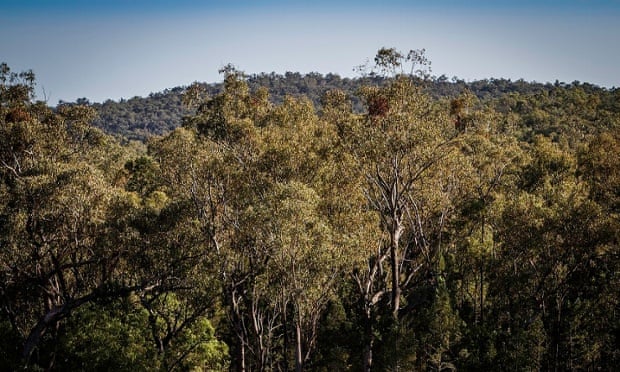Extract from The Guardian
Between 3m and 6m hectares of forest, mainly across New South Wales and Queensland, could be lost between 2010 and 2030

Eastern Australia is one of the world’s 11 deforestation hotspots
that together will account for 80% of global forest loss by 2030, a new
report has warned.
Between 3m hectares and 6m hectares of rainforest and temperate forest, mainly stretching across New South Wales and Queensland, could be lost between 2010 and 2030 on current trends, according to the World Wildlife Fund’s Living Forests report.
This deforestation is part of a wider loss that could reach 170m hectares of forest worldwide by 2030 in 11 key areas, including the Amazon, Borneo, Sumatra, the Congo Basin and East Africa.
Ten of the 11 areas are found in the tropics and contain some of the greatest biodiversity in the world, including animals such as tigers, orangutans and gorillas, as well as Indigenous communities.
About 70% of the eastern forests of Australia have already been cleared or disturbed, with just 18% of the area under any sort of protection, the WWF report states. Australia’s forestry loss has primarily been caused by land clearing for livestock, with unsustainable logging and mining also blamed for tree felling.
WWF said the watering down of environmental protections by the previous LNP government in Queensland led to a sharp rise in land clearing, with 275,000ha torn down in the past financial year – a tripling of vegetation loss rates since 2010.
While the new Labor state government has promised to reverse this loss, the New South Wales government is set to amend land-clearing protections, despite pledging $100m to protect the state’s threatened plants and animals.
“We are deeply concerned about NSW,” said Dermot O’Gorman, chief executive of WWF Australia. “These are laws that have been shown to have been effective in saving hundreds of thousands of animals, so it’s important that biodiversity continues to be protected.
“Maintaining forest protections is vital at state level. We’ve lost the large majority of the eastern Australian forest, which means the remaining forests are even more important to maintain.
“If business as usual continues, we will see more Australian species disappear, as well as the continuing decline of our water, topsoil and local and regional climate.”
O’Gorman said he welcomed the Australian government’s funding of efforts to slow deforestation in places such as Indonesia – where huge tracts of forest have been cleared to make way for palm oil plantations – but that some domestic policy decisions, such as the failed attempt to strip world heritage protection from part of Tasmania’s forests, was “unhelpful”.
The WWF report recommends a range of policies for the areas set to suffer deforestation, such as sustainable forest management practices, removing harmful agricultural practices, expanding protected areas and strengthening land rights for Indigenous people.
Between 3m hectares and 6m hectares of rainforest and temperate forest, mainly stretching across New South Wales and Queensland, could be lost between 2010 and 2030 on current trends, according to the World Wildlife Fund’s Living Forests report.
This deforestation is part of a wider loss that could reach 170m hectares of forest worldwide by 2030 in 11 key areas, including the Amazon, Borneo, Sumatra, the Congo Basin and East Africa.
Ten of the 11 areas are found in the tropics and contain some of the greatest biodiversity in the world, including animals such as tigers, orangutans and gorillas, as well as Indigenous communities.
About 70% of the eastern forests of Australia have already been cleared or disturbed, with just 18% of the area under any sort of protection, the WWF report states. Australia’s forestry loss has primarily been caused by land clearing for livestock, with unsustainable logging and mining also blamed for tree felling.
WWF said the watering down of environmental protections by the previous LNP government in Queensland led to a sharp rise in land clearing, with 275,000ha torn down in the past financial year – a tripling of vegetation loss rates since 2010.
While the new Labor state government has promised to reverse this loss, the New South Wales government is set to amend land-clearing protections, despite pledging $100m to protect the state’s threatened plants and animals.
“We are deeply concerned about NSW,” said Dermot O’Gorman, chief executive of WWF Australia. “These are laws that have been shown to have been effective in saving hundreds of thousands of animals, so it’s important that biodiversity continues to be protected.
“Maintaining forest protections is vital at state level. We’ve lost the large majority of the eastern Australian forest, which means the remaining forests are even more important to maintain.
“If business as usual continues, we will see more Australian species disappear, as well as the continuing decline of our water, topsoil and local and regional climate.”
O’Gorman said he welcomed the Australian government’s funding of efforts to slow deforestation in places such as Indonesia – where huge tracts of forest have been cleared to make way for palm oil plantations – but that some domestic policy decisions, such as the failed attempt to strip world heritage protection from part of Tasmania’s forests, was “unhelpful”.
The WWF report recommends a range of policies for the areas set to suffer deforestation, such as sustainable forest management practices, removing harmful agricultural practices, expanding protected areas and strengthening land rights for Indigenous people.
No comments:
Post a Comment